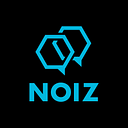NOIZ is creating a cognitive ad to increase the return on investment (ROI) for advertisers. How is the cognitive ad going to do this? It’s going to be using 3 forms of artificial intelligence (AI).
Don’t have time to watch a video? No worries! Here’s the quick read.
AI #1: Cognitive Ad
The first form of AI is what makes the ad ‘cognitive’. It learns based off of how users, or consumers engage with it.
So let’s say, for an example, an airline company comes to NOIZ and says they want to create a cognitive ad. It would have a beautiful airplane flying in the sky, and this beautiful image would have a dialogue box. This is where the cognitive part comes into play. So this dialogue box would enable the consumer, the user to interact with the ad.
Let’s say the ad asks the question, “Where would you like to go on your next trip?” It then gives you three options, as buttons, and a line where you can type. Let’s say those three options are London, Singapore and Cape Town. You end up choosing Cape Town, so as a result of you selecting a button rather than typing in an answer, you have just taught the ad something about your choices, or your options; and now, in the future, after you’ve done many engagements with the ad, where you’ve taught it your preferences, the ad will then cater an advertisement that’s specific to you, which increases your engagement with the ad.
But why would you want to keep engaging with an ad? You could do better things with your day. To incentivize you to continue talking with the ad, to converse with it, what NOIZ does is it will give you a token in return for your engagement, for your intent. So now, the advertiser gets a piece of data, a piece of information, every time you interact with the ad. It could be telling the ad what destination you want to go to for your trip; it could be telling the ad you want an aisle seat or a window seat; and this information goes to the advertiser directly.
AI #2 & #3: REM & Passive Monitoring
The other forms of AI that the cognitive ad will be using are known as Run-time Execution Monitoring (REM) and Passive Monitoring. What these two programs will be doing is monitoring how a consumer interacts with the ad, but it’s going to be a different type of interaction from the one described above. It will be how the consumer’s mouse moves across the screen; and then when they click on the advertisement, how much time did that take? It will analyze the time, how quickly you type in something to the cognitive ad part, the dialogue box; it can analyze how your mouse moves to select the options from the conversation box, and when it analyzes this and cross-references it to other users, what it does is determine if the users are similar to spambots or if they’re similar to humans.
Humans, we’re flawed. We make mistakes. We’re sporadic. Whereas a bot is programmed to act in a certain way, so we can figure out how the bots are acting and we can filter out all of that Spambot traffic.
Increased ROI for Advertisers
Now, the advertiser is getting a higher ROI as a result of increased engagement from a cognitive ad that is catered to each consumer in addition to the reward, which increases the consumers engagement with the ad, and then the other thing that’s bringing up the ROI for the advertiser is NOIZ’s ability to filter out the spam traffic, so now, the data that’s going back to the advertiser is clean.
They get clean data and higher engagement and an optimized ROI. This is how NOIZ is unique from other ad exchange networks. It’s the fact that we have these three forms of AI with blockchain. This is how NOIZ is disrupting the digital ad industry.
Learn more about the NOIZ project by clicking here and stay up to date on all things NOIZ by joining the NOIZ telegram channel.
